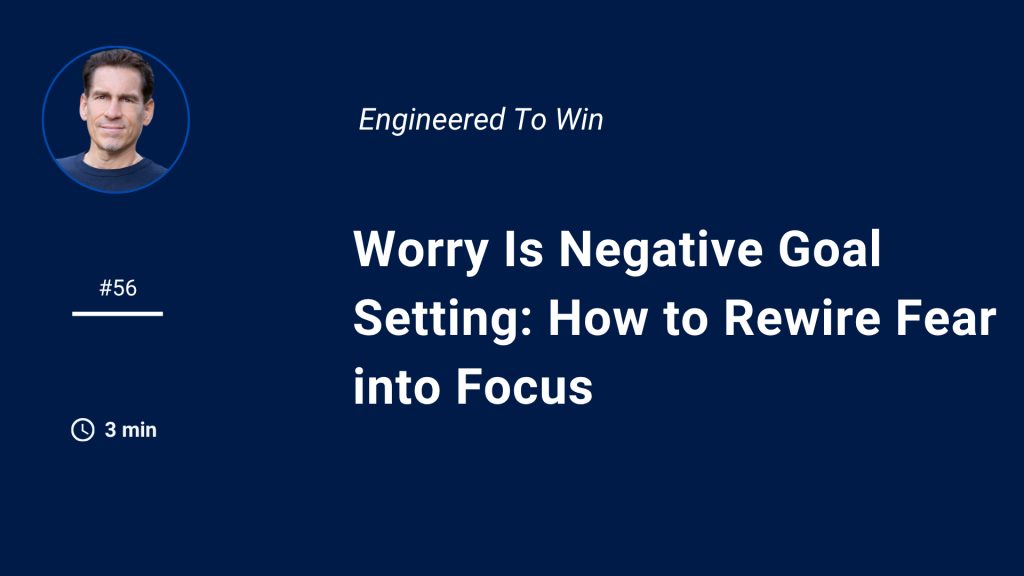Every time you worry about money, you’re not preparing — you’re rehearsing the result you fear most.
Worry is visualization in reverse: a mental loop that trains your brain for defeat, not victory.
Founders often mistake worry for diligence, but the brain doesn’t discriminate between imagined and real threats. When you repeatedly run “what if” scenarios, your nervous system treats that as training for failure.
Why Worry Feels Like Work — But Doesn’t Deliver
The brain evolved to prioritize threat prediction, not possibility creation. When uncertainty hits:
- The amygdala senses danger and floods your body with stress hormones.
- Your prefrontal cortex (the thinking planner) gets hijacked, reducing clarity, insight, and risk tolerance.
- You default to safe bets and small moves — even when your vision demands more.
The more you worry, the stronger you train your brain to manufacture more worry. It becomes habit.
From Worry to Clarity: The Neuroscience of Fear-Setting
If worry is unconscious negative goal setting, fear-setting is its conscious inversion — a tool to define, contain, and transmute fear.
Naming your fears activates the prefrontal cortex, which in turn helps calm the amygdala. Here’s one freely available open link on this dynamic:
“Be Mindful and Name That Feeling” — Mediate.com
For a deeper look at how emotional safety and money mindset are connected, read Poverty Isn’t Financial — It’s Emotional
This article discusses how labelling emotions can reduce amygdala reactivity and give your brain space to respond instead of merely reacting. (Mediate.com)
In short: naming the fear weakens its hold, shifting your brain from rumination to hypothesis-testing.
The Fear-Setting Practice (10 Minutes)
When the loop of worry takes over, pause and run through this five-step process. Write your answers quickly, without judgment.
1. Define the Nightmare
What’s the worst-case scenario if you take the action you’re afraid of?
Be vivid: loss, rejection, embarrassment. Is it life-ending or ego-bruising?
2. Repair the Damage
If the worst happens, what steps could you take to recover?
Break it down: support, resources, timelines.
3. Reframe Probability
How likely is that nightmare, realistically?
Have others survived worse? Use evidence to disrupt emotional overstatement.
4. Identify What You’re Avoiding
What possibility are you blocking by staying in fear?
Often, the thing you're avoiding is exactly the growth edge you need to cross.
5. Calculate the Cost of Inaction
What are you losing — emotionally, financially, relationally — by not acting?
Sketch 1-, 5-, and 10-year outcomes if nothing changes.
A Client Story: When Worry Became Strategy
Meet Liam.
He led a marketing agency that had scaled quickly — but he also carried hidden anxiety. Whenever revenue dipped slightly, his mind ran a scenario: “What if clients vanish?”
In sessions, he admitted he’d never defined collapse. It was a blur of tension, dread, and inaction.
We ran through the fear-setting questions, and he realized his worst-case wasn’t terminal. It was recoverable — with a plan.
That clarity shifted him from reaction to decision. Over weeks, his sleep improved, proposals were sent with confidence, and he operated from possibility rather than panic.
⚡ Quick Action Challenge: 5 Days of Fear-Setting
Over the next 5 days:
- Choose one recurring fear loop (money, clients, time, health).
- Each day, answer one fear-setting question from above.
- Don’t overthink — just write.
By week’s end, you’ll have transformed five invisible fears into concrete outlines, giving your brain clarity over chaos.
Expert Insight: Curiosity Beats Rehearsal Loops
Psychologist and neuroscientist Judson Brewer describes how observing fear with curiosity activates brain circuitry that separates feeling from reaction. This pause interrupts the default worry loop and gives space for alternative responses.
As he puts it:
“Curiosity is stronger than fear — it rewires the brain toward learning instead of looping.”
That shift is the difference between being trapped and being free.
Closing Thought + Reflection
Worry doesn’t protect you. It limits you.
Fear-setting is clarity turned into strategic courage.
You’ll never out-earn your internal rehearsal loop.
But when you define it, you shorten its power.
Reflection question:
Which fear are you refusing to define — and what freedom might open if you gave it structure?
Recommended Tool
Use Notion or Google Docs to build a “Fear-Setting Journal.”
Create daily entries using the five prompts, and tag them under #CognitiveCEO so you can revisit patterns.
Call to Action
If this landed, forward it to another founder trapped in mental loops.
Next week: You Don’t Work for Money — Money Works for You.

